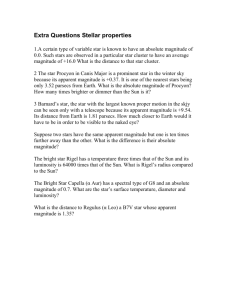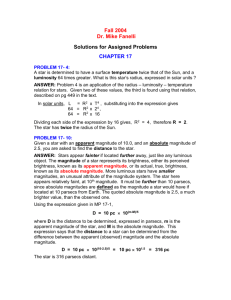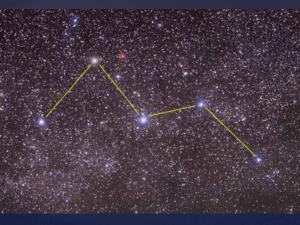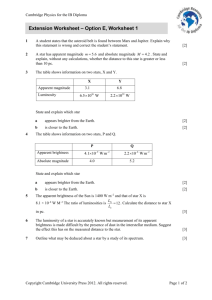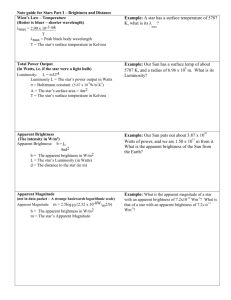Magnitude Problems
advertisement
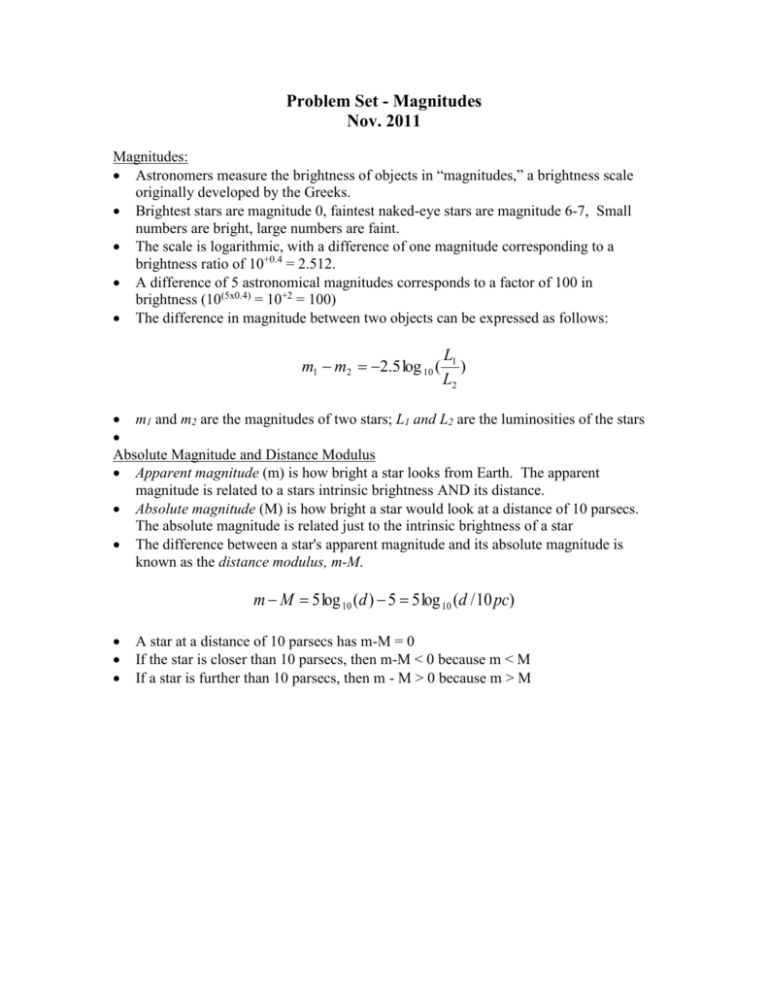
Problem Set - Magnitudes Nov. 2011 Magnitudes: Astronomers measure the brightness of objects in “magnitudes,” a brightness scale originally developed by the Greeks. Brightest stars are magnitude 0, faintest naked-eye stars are magnitude 6-7, Small numbers are bright, large numbers are faint. The scale is logarithmic, with a difference of one magnitude corresponding to a brightness ratio of 10+0.4 = 2.512. A difference of 5 astronomical magnitudes corresponds to a factor of 100 in brightness (10(5x0.4) = 10+2 = 100) The difference in magnitude between two objects can be expressed as follows: m1 m2 2.5 log 10 ( L1 ) L2 m1 and m2 are the magnitudes of two stars; L1 and L2 are the luminosities of the stars Absolute Magnitude and Distance Modulus Apparent magnitude (m) is how bright a star looks from Earth. The apparent magnitude is related to a stars intrinsic brightness AND its distance. Absolute magnitude (M) is how bright a star would look at a distance of 10 parsecs. The absolute magnitude is related just to the intrinsic brightness of a star The difference between a star's apparent magnitude and its absolute magnitude is known as the distance modulus, m-M. m M 5 log 10 (d ) 5 5 log 10 (d / 10 pc) A star at a distance of 10 parsecs has m-M = 0 If the star is closer than 10 parsecs, then m-M < 0 because m < M If a star is further than 10 parsecs, then m - M > 0 because m > M Magnitude Questions – For some questions you will want to refer to the color magnitude diagram above. 1. Two main sequence stars appear equally bright in the night sky. Star D has a spectral class of M2 and Star E has a spectral class of B8. a. Which star has a greater absolute magnitude? (K40) b. How many magnitudes greater? (K41) c. Which is hotter? (K42) d. Which emits more energy per unit surface area (K43) e. How many times more? (K44) f. Which is farther from the observer? (K45) g. How many times further? (K46) 2. A star identical to the Sun has an apparent magnitude of +8.56. How far away is it in light years? (L16) 3. A star is observed to have an apparent magnitude equal to its absolute magnitude. What is the distance to the star? (Mc8) 4. If a supernova has an absolute visual magnitude of -25, what is its visual luminosity in terms of the Sun's luminosity? (Q29) 5. All RR Lyrae stars have an absolute visual magnitude of 0.75. One RR Lyrae star has an apparent magnitude of 13.5. How many light years away is this object? (Q(D)5) 6. RR Lyrae stars have approximately the same absolute magnitude of +0.5 and are common in globular clusters. An RR Lyrae star in one globular cluster has an apparent magnitude of 16.5. What is the distance to the cluster in light years? (R26) (Don't hold me responsible for inconsistencies from one test to the next!!!) 7. In 1974 a radio message was sent toward the globular cluster Messier 13. It would take 46,000 years before we could receive an answer back. The apparent magnitude of M13 is 5.8. What is its absolute magnitude? (R32) 8. A star's apparent magnitude is +6.5 and its absolute magnitude is 0.22. What is the distance in parsecs to the star? Additional Questions Which star is brighter in the night sky, one with apparent magnitude m=3 or one with m=8? ____________ Which star would be visible to the naked eye in a dark setting? ____________ Stars 1 and 2 have magnitudes m1 and m2, respectively. What can you say about their apparent brightness if m1 = m2? __________What if m1 > m2? _____________ Stars A, B, C, D, and E have magnitudes of 5, 3, -1, 15, and 0, respectively. Which star appears brightest to us? _________Which appears faintest? ________ Arrange the stars in order of declining brightness _______________. Complete column two in the table below: Difference in magnitude between Star A and Star B, mB - mA 0 2.5 5 7.5 10 12.5 How many time brighter Star A is than Star B Equal brightness 10 100 An astronomer measures the magnitude of Star A and finds it is 12.5. She measures a magnitude of 2.5 for Star B. Which one is brighter, and by how much? ___________ Vega has an apparent magnitude of 0.04 while Deneb has an apparent magnitude of 1.26. If you look at these two stars at night, which will appear brighter? How many times brighter is it? _______________ Suppose Star S and Star T have the same luminosity; that is, they radiate energy at the same rate ("watts" as in a light bulb), but Star S is more distant than Star T. Which star will appear brighter in the sky? ______________ Which will have the greater apparent magnitude? ____________ Two supernovae occur in different galaxies. If both supernovae have the same luminosity, how will you tell which galaxy is more distant? A star has a distance of 10 parsecs and an apparent magnitude of 5. What is the absolute magnitude of the star? _____________ What is the distance modulus?_____________ A star has a distance of 20 parsecs and an apparent magnitude of 3. Will its absolute magnitude be larger or smaller than 3? _________________ Vega is a bright star with an apparent magnitude of approximately 0 and a distance of approximately 8 parsecs. Will its absolute magnitude be positive or negative? _____ Will its distance modulus be positive or negative? __________________ We can relate the distance modulus to the distance in parsecs through the expression: d = 10 x 10 (m-M)/5 For example, if the distance modulus m-M = 10, d = 10 x 10(10/5) = 103 parsecs Fill in the table below: Apparent Mag mV 6 10 13 5 7.5 12 19 Absolute Mag MV 1 15 13 0 -2.5 6 -6 Distance Modulus m-M Distance in parsecs Suppose you measure the apparent magnitude of the star Deneb to be m=1.25. It has an absolute magnitude of -8.75. What is its distance modulus? _____________ What is its distance in parsecs? The star Rigel has an apparent magnitude of 0.1 and is located about 250 parsecs away. What is the absolute magnitude of Rigel? A star is known to have an apparent magnitude of -26 and an absolute magnitude of 4. Where might this star be located? What is the name of this star? Answer Key – Magnitude Problems 1a. 1b. 1c. 1d. 1e. 1f. 1g. 2. 3. 4. 5. 6. 7. 8. Star E, the B8 star (K40) About 10 mags (K41) Star E, the B8 star (K42) Star E, the B8 star (K43) *about 60 times more (K44 – 39) Star E, the B8 star (K45) 100 times further (K46) 180 LY (L16) 10 pc (Mc8) 1012 times greater (Q29) *11,500 (7200 LY Q(D)5) 50,000 LY (R26) -8.5 (R32) 180 pc

